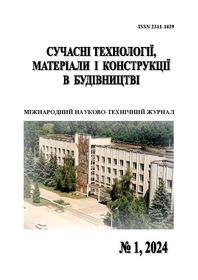PRINCIPLES OF APPLICATION OF THE SOIL EINFORCEMENT METHOD WITH HORIZONTAL ELEMENTS IN COMPLEX SOIL CONDITIONS
DOI:
https://doi.org/10.31649/2311-1429-2024-1-76-80Keywords:
horizontal flexible elements, soil reinforcement, complex soil conditions, reinforcement parametersAbstract
Soil reinforcement with horizontal linear flexible elements is used in almost all branches of geotechnical practice, when placing a construction site in difficult soil conditions. Let's consider in more detail each of the difficult construction conditions, such as areas faked by mining, subsidence soils, areas dangerous for the possibility of sufosis and karst, landslides, as well as loose and organic soils, using the example of pillow reinforcement under the foundation of the building that will be erected. In this case, it is necessary to comply with such requirements as sufficient strength of the reinforcement elements and the optimal contact surface of the elements with the soil. First of all, we will consider the principle of using this method during construction on territories that have already been tampered with or will be tampered with in the future by mining and underground urban structures. In addition to the displacement trough, which is directly formed over a certain period of time above the mine, within which subsidence, tilting, curvature deformation, compression and stretching of the earth's surface occur, other dangerous processes that reach the earth's surface are also possible: soil compaction from drainage, which leads to the subsidence of the layers that lie above and ends with the subsidence of the earth's surface with the formation of a drainage basin of subsidence; sufosis into an underground working, as a result of which a sufosis cavity is formed, and depending on its height, either collapse or subsidence of the soil occurs, and a sufosis depression or a sufosis mound of displacement is formed on the earth's surface, respectively. In buildings, the effect of reinforcement is manifested in two ways. First of all, due to its tensile strength, reinforcement prevents the displacement of some parts of the soil mass relative to others. Secondly, the interlayer, which works in harmony with the soil, causes a redistribution of stresses from overloaded areas to neighboring unloaded areas and involves them in work. The introduction of such a layer allows you to strengthen the dangerous or weakened area of the structure and ensure its sufficient strength. The introduction of horizontal reinforcing elements into the soil base, which will absorb part of the tensile forces, will significantly limit these deformations. Тhe destruction of reinforced soil structures located in counterfeit territories is characterized by the rupture of reinforcing elements due to the stretching of the earth's surface, therefore it is necessary to ensure their required strength, as well as the length of reinforcing elements. It is also desirable to anchor the ends of the reinforcing elements, if their number is at least 4. This will prevent reinforcement elements from slipping in the soil, which will reduce the settlement of foundations of buildings and structures.
References
Drukovany M.F., Dudar I.N., Korchevskyi B.B., Kovalskyi R.K. Factors affecting the effectiveness of soil reinforcement // Visnyk VPI. – 2001. - No. 5. - with. 22 - 27.
Song, Xiaoruan, Miansong Huang, Shiqin He, Gaofeng Song, Ruozhu Shen, Pengzhi Huang, and Guanfang Zhang. "Erosion Control Treatment Using Geocell and Wheat Straw for Slope Protection." Advances in Civil Engineering 2021 (April 10, 2021): 1–12. http://dx.doi.org/10.1155/2021/5553221.
Drukovany M.F., Korchevskyі B.B. Strengthening of soil foundations with reinforcing pillows made of fiberglass mesh. Results of laboratory tests. Naukovo-tekhnichnyy zhurnal "Building structures" No. 53. Book 2 - K.: NDIBK - 2000, p.94-99.
YAMAZAKI, Takayuki, Toyoji YONEZAWA, Masaru TATEYAMA, and Fumio TATSUOKA. "2E12 Design and construction of geosynthetic-reinforced soil structures for Hokkaido Shinkansen(Infrastructure)." Proceedings of International Symposium on Seed-up and Service Technology for Railway and Maglev Systems : STECH 2015 (2015): _2E12–1_—_2E12–12_. http://dx.doi.org/10.1299/jsmestech.2015._2e12-1_.
Pant, Aali, Manoj Datta, and G. V. Ramana. "Bottom ash as a backfill material in reinforced soil structures." Geotextiles and Geomembranes 47, no. 4 (August 2019): 514–21. http://dx.doi.org/10.1016/j.geotexmem.2019.01.018.
Trovato, F., G. Intrevado, P. Pezzano, and G. Lugli. "Reinforced Soil Structures: From Standard Design to BIM." IOP Conference Series: Materials Science and Engineering 1260, no. 1 (October 1, 2022): 012034. http://dx.doi.org/10.1088/1757-899x/1260/1/012034.
Korchevskyi B.B., Kolesnyk A.V. Theoretical calculation of reinforced foundations taking into account soil anisotropy //Modern technologies, materials and structures in construction. - 2023. - Vol. 34, No. 1. - P. 69-79.
Portelinha, Fernando H. M., Jorge G. Zornberg, and Orencio M. Vilar. "Deformation analysis of an unsaturated geosynthetic reinforced soil wall subjected to infiltration." MATEC Web of Conferences 337 (2021): 03018. http://dx.doi.org/10.1051/matecconf/202133703018.
Hoffman, Peter. "Disruption, innovation, and opportunity with reinforced soil structures." IOP Conference Series: Earth and Environmental Science 727, no. 1 (April 1, 2021): 012019. http://dx.doi.org/10.1088/1755-1315/727/1/012019.
Sabri, Mohanad Muayad Sabri, Nikolai Ivanovich Vatin, Renat Rustamovich Nurmukhametov, Andrey Budimirovich Ponomarev, and Mikhail Mikhailovich Galushko. "Vertical Fiberglass Micropiles as Soil-Reinforcing Elements." Materials 15, no. 7 (April 1, 2022): 2592. http://dx.doi.org/10.3390/ma15072592.
Downloads
-
pdf (Українська)
Downloads: 63



